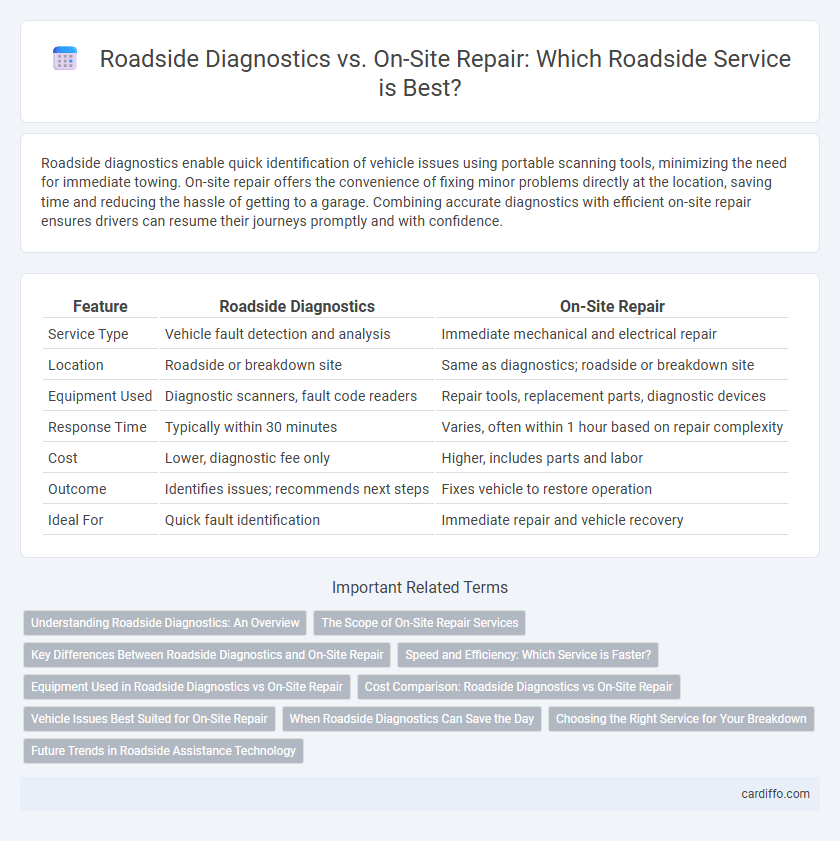Roadside diagnostics enable quick identification of vehicle issues using portable scanning tools, minimizing the need for immediate towing. On-site repair offers the convenience of fixing minor problems directly at the location, saving time and reducing the hassle of getting to a garage. Combining accurate diagnostics with efficient on-site repair ensures drivers can resume their journeys promptly and with confidence.
Table of Comparison
| Feature | Roadside Diagnostics | On-Site Repair |
|---|---|---|
| Service Type | Vehicle fault detection and analysis | Immediate mechanical and electrical repair |
| Location | Roadside or breakdown site | Same as diagnostics; roadside or breakdown site |
| Equipment Used | Diagnostic scanners, fault code readers | Repair tools, replacement parts, diagnostic devices |
| Response Time | Typically within 30 minutes | Varies, often within 1 hour based on repair complexity |
| Cost | Lower, diagnostic fee only | Higher, includes parts and labor |
| Outcome | Identifies issues; recommends next steps | Fixes vehicle to restore operation |
| Ideal For | Quick fault identification | Immediate repair and vehicle recovery |
Understanding Roadside Diagnostics: An Overview
Roadside diagnostics involve using advanced diagnostic tools and software at the roadside to accurately identify vehicle issues before repair. This process allows technicians to quickly detect engine faults, battery status, and other system errors, minimizing downtime and preventing unnecessary repairs. Understanding roadside diagnostics enhances service efficiency by enabling precise problem identification directly at the breakdown location.
The Scope of On-Site Repair Services
On-site repair services encompass a comprehensive range of diagnostics, maintenance, and mechanical fixes conducted directly at the vehicle's location, eliminating the need for towing. These services include battery replacement, tire changes, brake repairs, and engine diagnostics, providing immediate solutions that minimize downtime. The scope extends beyond basic roadside assistance by offering complex repairs, leveraging advanced diagnostic tools to detect and resolve issues on the spot.
Key Differences Between Roadside Diagnostics and On-Site Repair
Roadside diagnostics involve identifying vehicle issues using specialized tools and software at the breakdown location, primarily focusing on detecting faults quickly and accurately. On-site repair goes beyond diagnostics by performing immediate mechanical fixes or replacements at the scene to restore vehicle functionality. The key difference lies in diagnostics targeting problem identification, whereas on-site repair addresses problem resolution without towing the vehicle.
Speed and Efficiency: Which Service is Faster?
Roadside diagnostics provide rapid assessment by identifying vehicle issues within minutes using advanced scanning tools, enabling quick decision-making. On-site repair involves immediate troubleshooting and fixing, but the complexity of repairs can affect overall speed and efficiency. Choosing roadside diagnostics ensures faster pinpointing of problems, while on-site repair prioritizes efficient resolution depending on the vehicle's condition.
Equipment Used in Roadside Diagnostics vs On-Site Repair
Roadside diagnostics utilize specialized portable diagnostic scanners and code readers that interface directly with vehicle onboard computers to quickly identify issues. On-site repair involves mobile toolkits including pneumatic tools, battery testers, and welding equipment to perform mechanical fixes and parts replacement directly at the breakdown location. Advanced handheld devices enable instant data retrieval, while on-site repair equipment supports comprehensive mechanical interventions beyond mere diagnostics.
Cost Comparison: Roadside Diagnostics vs On-Site Repair
Roadside diagnostics typically incur lower initial costs by quickly identifying vehicle issues without the overhead of full repairs on-site. On-site repair expenses tend to be higher due to labor, parts replacement, and the need for specialized tools and equipment brought to the location. Businesses and vehicle owners often choose roadside diagnostics to minimize downtime and avoid the more substantial costs associated with immediate on-site repairs.
Vehicle Issues Best Suited for On-Site Repair
On-site repair is ideal for addressing vehicle issues such as battery replacement, tire changes, and minor engine repairs that can be efficiently resolved without towing. Diagnostic services performed roadside help identify problems like sensor malfunctions or fluid leaks but often require more extensive shop equipment for thorough repairs. Prioritizing on-site repair for common and straightforward issues reduces towing costs and minimizes vehicle downtime, enhancing overall roadside assistance effectiveness.
When Roadside Diagnostics Can Save the Day
Roadside diagnostics can save the day by quickly identifying vehicle issues without the need for a tow, minimizing downtime and inconvenience. Advanced diagnostic tools used by roadside technicians analyze engine codes, battery health, and tire pressure to determine the exact problem on-site. This immediate assessment enables timely fixes like jump-starting, tire changes, or minor repairs, preventing costly delays associated with on-site repair services at workshops.
Choosing the Right Service for Your Breakdown
Roadside diagnostics provide quick, accurate identification of vehicle issues using advanced scanning tools, enabling efficient decision-making during breakdowns. On-site repair offers immediate mechanical fixes at the breakdown location, minimizing towing costs and downtime. Choosing the right service depends on the severity of the problem, availability of tools, and urgency, ensuring prompt and cost-effective resolution.
Future Trends in Roadside Assistance Technology
Future trends in roadside assistance technology emphasize seamless integration of roadside diagnostics with on-site repair systems, enabling faster real-time problem identification and resolution. Advanced AI-driven diagnostic tools combined with mobile repair units enhance accuracy and efficiency, reducing vehicle downtime significantly. Autonomous repair drones and connected vehicle platforms are expected to revolutionize service delivery by providing instant roadside repairs based on predictive analytics and remote diagnostics.
Roadside Diagnostics vs On-Site Repair Infographic

 cardiffo.com
cardiffo.com